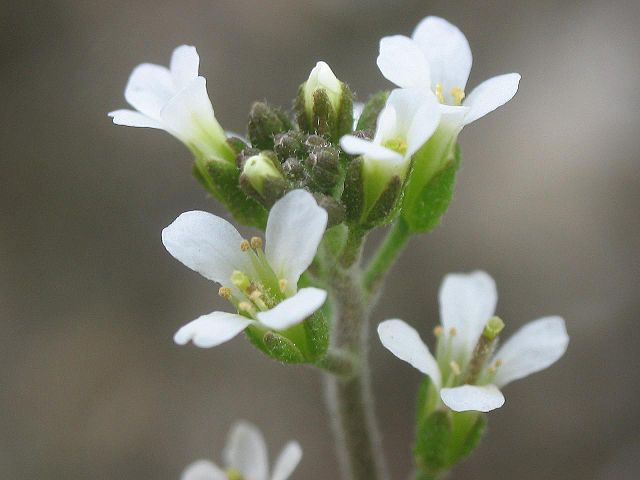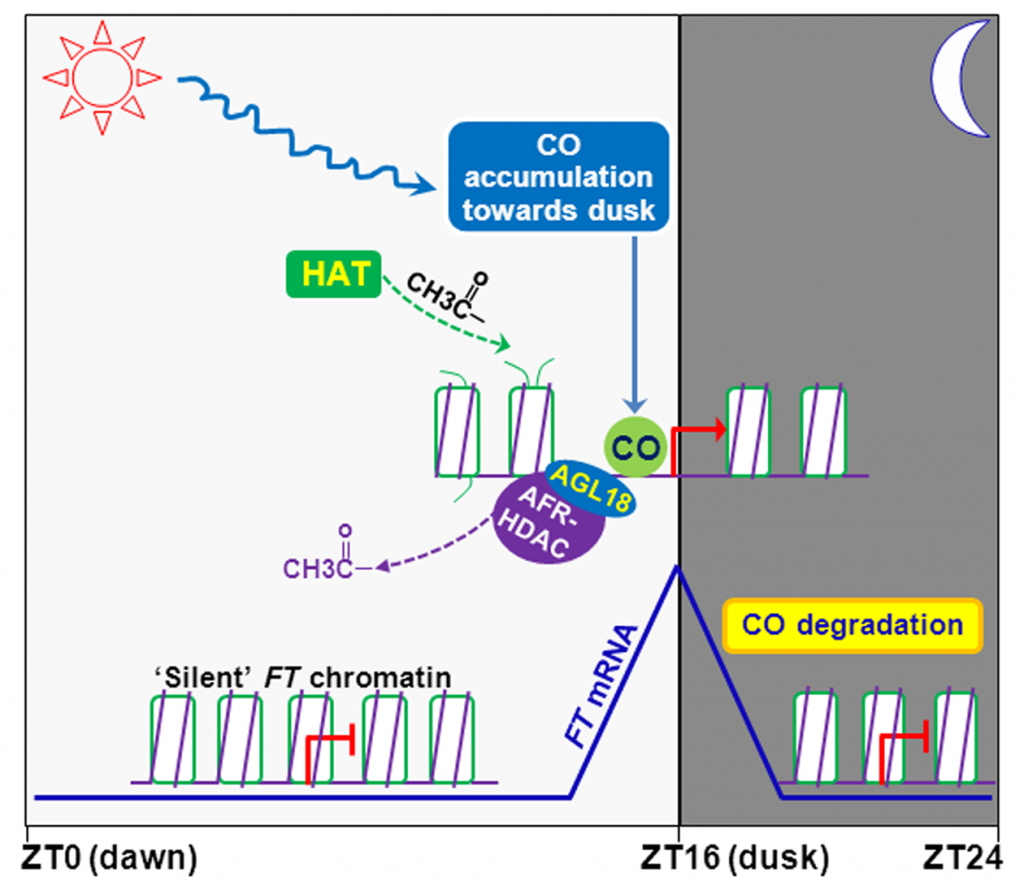Alarm clocks for plants
Subject areas: Cell biology, Botany
Vocabulary:
histones – compact protein complexes found in the nucleus of eukaryotic cells. They have a lot of positive charges on their outward-facing sides, which allows them to hold onto DNA, which is positively charged. They function to wrap and organize DNA, which would otherwise be a crazy tangle.
histone acetylation/deactylation – The part of the DNA that is wrapped around the histone is mostly inaccessible for use, sort of like being in storage. For the cell to make something from the information on the DNA, that part of the DNA has to be released from the histone. This is done by a HAT, or histone acetyltransferase. It adds a chemical tag (acetyl group) onto the histone in several places. This tag is negatively charged, and therefore repels the negatively charged DNA. When it is time to wrap that DNA back up, an HDAC (histone deactylase) comes by and takes the chemical tag off, so the histone is positively charged again and can bind the DNA. Simple, but effective.
transcription – the process of copying information on the DNA into RNA
translation – the process of using the information on an RNA to make a protein
The article:
Gu, X. et al. (2013) Photoperiodic Regulation of Flowering Time through Periodic Histone Deacetylation of the Florigen Gene FT. PLoS Biol 11(9): e1001649. doi:10.1371/journal.pbio.1001649
The Broad Question
Arabidopsis, as well as many other flowering plants, have precisely timed flowering periods in order to maximize reproduction. This means making sure they flower early enough that there is plenty of time to grow mature fruit, but not so early that a cold snap could destroy young buds, or before pollinating animals (birds, bees, etc) are around. How do plants do this? What kind of mechanism is used to control whether a plant will flower?
What Is Already Known
The length of day (as opposed to night), or photoperiod, is a major environmental signal to the flowering cycle. It is sensed by the leaves, through a mechanism that produces CO protein, which is is a transcription factor that binds to the promoter region of the florigen gene. The leaves produce a small protein called florigen, which is then transported out of the leaves through the phloem, and eventually reaching the shoot apical meristems, or SAM. These SAMs are the areas on all plants were new above-ground growth occurs, including the development of flowers. So, an increase in daylight will lead to an increase in florigen.
Very quick reminder of how DNA “works”:
- The DNA has the information for making all the proteins in the body. It is gigantically long but really thin, and has to be organized by wrapping around histones or it gets so tangled it’s unusable.
- Genes are sequences along the DNA that encode something, and they all start with a specific promoter sequence and often enhancer sequences.
- Transcription factors recognize the promoter and enhancer sequences and bind to them.
- That brings in a transcription machine that makes an RNA copy of the DNA gene.
- After that, the RNA is processed and exported out of the nucleus, where it is translated into a protein.
How They Thought About The Problem
In most biological mechanisms, there are opposing forces to allow for a finer level of control. In this case, increased florigen can eventually lead to flowering, but what if increased daylight is not accompanied by warmer temperatures or other necessary factors? Is there a mechanism that prevents florigen production? Since the researchers knew that CO protein was a transcription factor that could turn on florigen production, they wanted to find something that could turn it off. This could be accomplished by blocking or turning off the transcription machine after it arrived at the florigen gene. Or, it could be accomplished by preventing access to that part of the gene altogether.
An HDAC (see above vocabulary section) could shut down access to the DNA, but they don’t operate specifically on florigen. However, the researchers thought, what if we looked for proteins that are found attached to HDACs that are also attached near the florigen gene?
They knew in general what HDACs are found around the florigen gene, but not what controls when they do it. They assume that there must be a protein that can recognize the DNA around the florigen and also recognize the HDAC, so that it can act as a sort of mediator or positioner for the HDAC to do its thing. That kind of thing wasn’t known for the flowering plant they were studying. But, they knew that HDACs are pretty similar across species, and in yeast, there is a well-characterized HDAC that binds with multiple proteins in a complex that represses the production of certain genes. Basically, that gave them a clue, so they looked for plant (in their case, arabidopsis) genes similar to the yeast ones, then tested to see if they formed an HDAC complex that could shut down florigen production.
I’m not going to talk about the technical details of what they did here. The important thing is the way that these scientists logically thought their way around the problem.
What They Found
As I said in the previous sentence, the reason I chose this article was more about the process than the actual result, but the result is still interesting. Basically, they found two proteins, called AFR1 and AFR2, that can complex with an HDAC to prevent production of florigen. An interesting note is that the photoperiod pathway leads to both CO production and AFR1/2 activation, simultaneously turning on and turning off florigen production. The balance of the two, probably regulated by yet other factors, is a key mechanism in regulating flowering.



No comments
Be the first one to leave a comment.